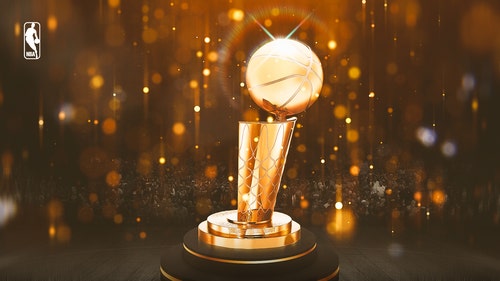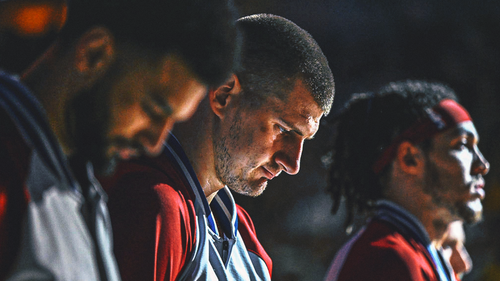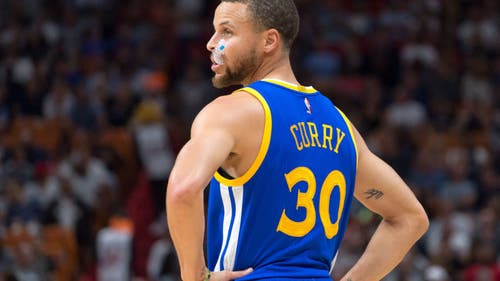
Comparing and contrasting Kyrie Irving and Mike Conley's surprisingly similar analytics
Oct 22, 2014; Memphis, TN, USA; Memphis Grizzlies guard Mike Conley (11) defends against Cleveland Cavaliers guard Kyrie Irving (2) during the first half at FedExForum. Mandatory Credit: Nelson Chenault-USA TODAY Sports
When I saw Memphis Grizzlies point guard Mike Conley was only one spot behind Kyrie Irving in Sports Illustrated’s “Top 100 NBA players of 2017” rankings, I decided to take a deeper look at how the two match up.
Kyrie Irving has had quite the summer: he won the NBA Finals with a game-winning shot over the first unanimous MVP in league history, partied on yachts and dazzled international basketball fans as he helped lead Team USA to a gold medal in Brazil.
Mike Conley also made the news this summer, signing the largest guaranteed deal in NBA history. In a classic Conley move, he didn’t give a very exciting answer when Mike & Mike asked about what he’d spend his first paycheck on:
“Really to be honest, I don’t even know,” Conley said. “Maybe my wife a car or something. Outside of that, I don’t think I’m touching it that much.”
Off the court, Irving and Conley couldn’t be more different. However, when I saw the two floor generals were only ranked one spot apart in SI’s “Top 100 NBA Players of 2017” rankings, I decided to compare their analytics from last season, as well as their on-court styles of play. Sometimes, when looking at the numbers, it’ll be obvious who is who, but the next moment it’ll be hard to decipher. So, can numbers lie?
Per 36 Minutes
Oct 22, 2014; Memphis, TN, USA; Memphis Grizzlies guard Mike Conley (11) drives around Cleveland Cavaliers guard Kyrie Irving (2) as forward Kevin Love (0) looks on at FedExForum. Memphis defeated Cleveland 96-92. Mandatory Credit: Nelson Chenault-USA TODAY Sports
I’ll consider this your warm-up, so we can start off easy. One of these players is Mike Conley, the other is Kyrie Irving.
Player A: 22.5 points, 5.4 assists, 3.4 rebounds, 1.2 steals, 2.7 turnovers, 19.0 FG attempts, 4.1 FT attempts
Player B: 17.5 points, 7.0 assists, 3.4 rebounds, 1.4 steals, 1.7 turnovers, 14.2 field goal attempts, 4.7 FT attempts
Kyrie Irving is player “A,” which shouldn’t be surprising given his reputation as a high-volume scorer. Not a lot to learn from these statistics other than that the two grab rebounds at about the same rate.
Shot Charts
Now, lets take a look at Kyrie Irving and Mike Conley’s shot charts. Keep in mind that Conley is left-handed.
The first shot chart is Conley, and at a quick glance, there are a lot of areas that he and Irving were alike. First off, both shot at an extremely high rate on 3s from the left corner and struggled on 3s from the top of the key. Both players were below average when it came to finishing at the rim, though Conley did average 0.8 more trips to the free throw line than Irving. The area where Irving excelled was on mid-range 2-pointers, shooting at an above average rate in all five zones outside the paint.
Advanced Stats
For anyone that needs a quick crash course on what these statistics below mean, check out this Basketball-Reference.com link.
PLAYER A |
PLAYER B |
|
19.4 |
PER | 19.9 |
| .538 | True Shooting % | .540 |
| .309 | 3-Point Attempt Rate | .298 |
.329 |
Free Throw Rate | .217 |
| 5.3 | Rebound % | 5.3 |
32.7 |
Assist % | 26.6 |
| 2.0 | Steal % | 1.7 |
| 9.5 | Turnover % | 11.4 |
22.4 |
Usage % | 29.5 |
| 5.3 | Win Shares | 5.0 |
.144 |
Win Shares per 48 Minutes | .143 |
| 1.7 | Box Plus/Minus | 1.6 |
| 1.7 | Value Over Replacement Player | 1.5 |
Wow. Almost identical, am I right? Mike Conley is player “A” and and Kyrie Irving is “B.” One glaring difference between the two players is Conley’s advantage via assists and turnovers (4.07 assist to turnover ratio). His free throw rate is higher, but he only made 0.2 free throws more than Irving per game, a negligible difference. A stat that will shock many was how those win shares were accumulated for each player (offensive vs. defensive), but we’ll get into that soon.
Also worth noting, Conley and Irving had very similar numbers in “player impact estimate,” a figure used to determine what percentage of a game’s events that player contributed to. Conley was at 12.9 last season, while Irving’s estimate was 12.2. Though, it can’t be forgotten that Irving plays alongside arguably the the NBA’s best all-around player ever, LeBron James.
Pick And Roll (Ball Handler)
Player A: 0.86 points per possession, 43.3% frequency, 40.9 eFG%, 9.5 TOV%
Player B: 0.89 points per possession, 43.6% frequency, 49.0 eFG%, 13.5 TOV%
Being able to handle the ball in a pick and roll offense is a crucial skill for every point guard in today’s NBA. Yet again, Irving and Conley shared similar numbers. Of players with at least 200 possessions as the ball handler in a PnR set, Irving and Conley were 13th and 15th in frequency. The shooting stats tip you off that player “B” is yet again Irving, but it shouldn’t have been shocking to find out. Both Conley and Irving have similar production in terms of points per possession, but Irving boasts an effective field goal percentage nearly eight percent higher than Conley’s. This tells you that Conley has to rely on ball security (his turnover rate is four percent lower) and passing to the roll man to get points on the board for the Memphis Grizzlies.
So, while they’re generating close to the same number of points in the same type of play, numbers don’t tell the whole story of how those points are put on the board.
Shot Preference
Player A
Player B
This time, Conley is player “B.” It doesn’t really much matter, though, as the duo share a similar preference in what kind of shots they take. As a matter of fact, they both pulled up at the exact same frequency and the area in which they differed the most—catch and shoots—they both had the exact same effective field goal percentage of 51.9.
Where the two differ greatly, though, is in isolation play. Irving more nearly tripled Conley in isolation attempts (153 to 56). That didn’t mean better production, though, as Conley’s 1.02 points per possession in was in the 89th percentile amongst all NBA players with at least ten attempts, as compared to 0.95 PPP for Irving (percentile: 80.1).
That being said, Irving and his dazzling crossovers make him arguably the most fun isolation player in the league to watch.
Defense
When Kyrie Irving’s critics cite their largest complaints, defense is almost always brought up. However, in nearly every metric, Irving has a surprising advantage over Mike Conley.
Irving closes out slightly better on shots, as his opponents shot 0.6 percent below the league average last season—a solid mark for point guards considering their usual lack of size means they get taken advantage of in the paint.
Conley, on the other hand, allowed his opponents to shoot 1.6 percent better than the league average. Though, his opponents did shoot 1.5 percent lower than the league average for 3-pointers, a mark better 1.1 percent better than Irving. However, he struggled on closing out on anything inside the arc.
According to Basketball-Reference.com, Irving’s defensive rating (team points allowed per 100 possessions when he’s on the court) of 106 was also better than Conley’s mark of 110. Similarly, Irving’s defensive box plus/minus of -1.4 was also better than Conley’s -1.9.
Jan 10, 2016; Philadelphia, PA, USA; Philadelphia 76ers guard Ish Smith (1) dribbles past the defense of Cleveland Cavaliers guard Kyrie Irving (2) during the second half at Wells Fargo Center. The Cleveland Cavaliers won 95-85. Mandatory Credit: Bill Streicher-USA TODAY Sports
I said we’d dive into the win shares later on, didn’t I? Well, the time has come. Conley had a slight edge, contributing 5.3 wins to the Memphis Grizzlies’ total of 42, while Irving had 5.0 of the Cleveland Cavaliers’ 57 wins.
Irving, considered one of the league’s most talented offensive players, actually had a lower number of offensive win shares than Conley, however, trailing 4.2 to 3.2. However, Irving had a 1.7 to 1.1 advantage in defensive win shares, a stat I doubt anyone saw (I mean, I sure didn’t) coming.
The one defensive area Conley had an advantage in was steals per 100 possessions, where he outnumbered Irving 2.0 to 1.7.
Head to Head
Dec 21, 2014; Cleveland, OH, USA; Memphis Grizzlies guard Mike Conley (11) trips while driving the lane against Cleveland Cavaliers guard Kyrie Irving (center) and forward Kevin Love (0) in the first quarter at Quicken Loans Arena. Mandatory Credit: David Richard-USA TODAY Sports
| Player | MP | FG | FGA | FG% | 3P | 3PA | FT | FTA | TRB | AST | STL | TOV | PF | PTS | |
| Mike Conley | 29.2 | 5.4 | 10.4 | .519 | 1.4 | 3.2 | 2.2 | 2.4 | 1.4 | 6.2 | 1.8 | 1.8 | 1.8 | 14.4 | |
| Kyrie Irving | 35.8 | 9.8 | 18.0 | .544 | 1.8 | 5.0 | 2.2 | 3.4 | 2.2 | 4.6 | 1.8 | 3.4 | 2.8 | 23.6 |
Playing in different conferences, Mike Conley and Kyrie Irving have only squared off five times in their careers, with Conley and the Memphis Grizzlies winning three of those contests. Obviously, Irving got his points going, scoring almost 10 more points per game than Conley (though, while also playing 6.4 more minutes per game). Conley, oddly, was blazing from behind the arc, shooting at least 50 percent in each game outside of an 0-for-4 night on Dec. 21, 2014, in which he barely logged more than 24 minutes.
As expected, Conley had more assists, but couldn’t out-rebound Irving. Conley did force 2.4 turnovers per game with 1.8 steals and 0.6 blocks. Irving had no blocks and also had 1.8 steals, but turned the ball over 3.4 times per contest.
So, Why Does This Mean Anything?
It means that numbers never lie and that, well, numbers can lie. When looking at only the duo’s advanced statistics on Basketball-Reference.com, they look like identical players. They both have the same numerical impact on games’ events, they’re just as efficient in terms of PER and they take similar kinds of shots. However, anyone who’s watched just one game each player will tell you their ways of running their teams as point guards couldn’t be farther apart.
Stepping away and looking at things above, numbers and the eye-test being both being used as criteria, it’s hard to comprehend why Conley often isn’t considered to be in same tier as Irving.
More from Beale Street Bears
This article originally appeared on











